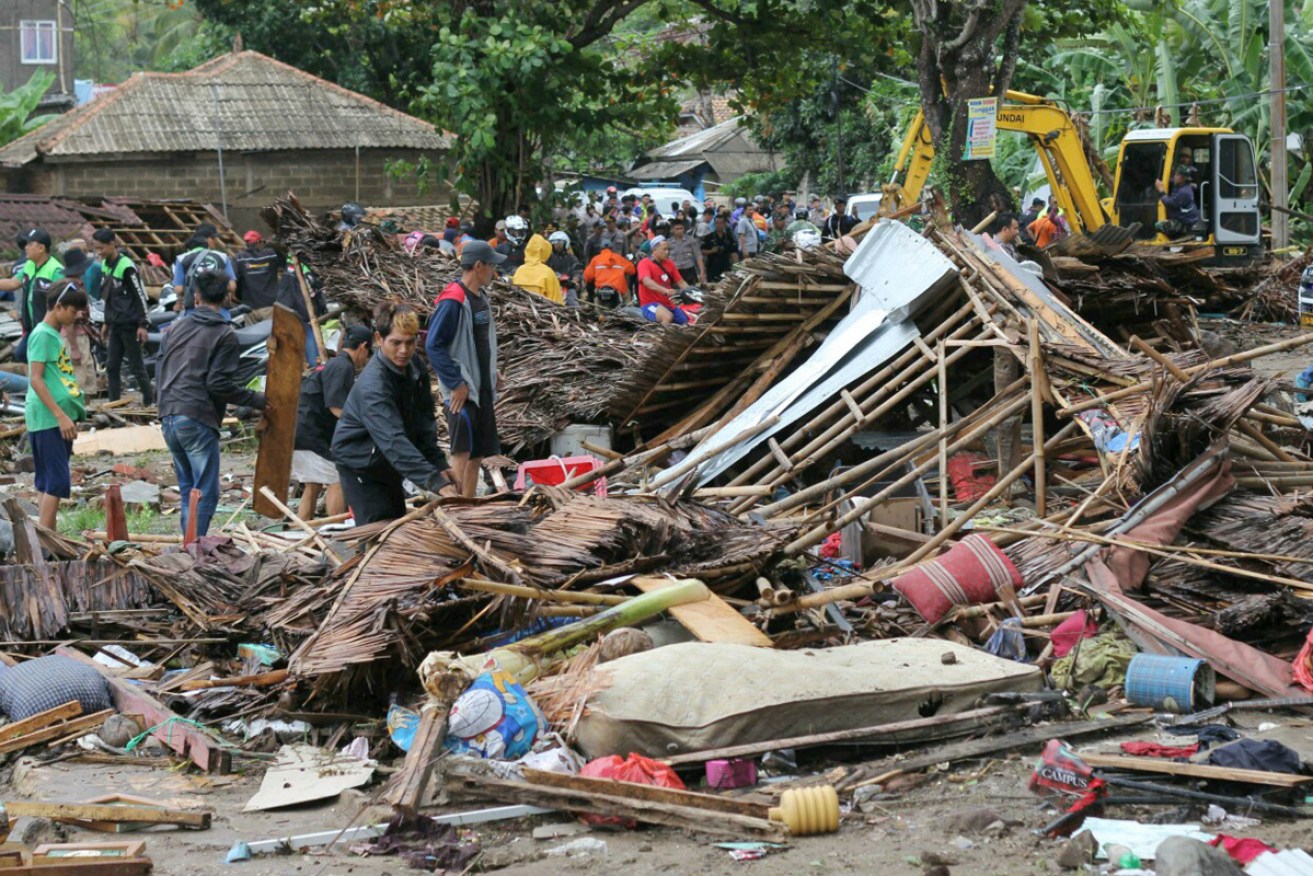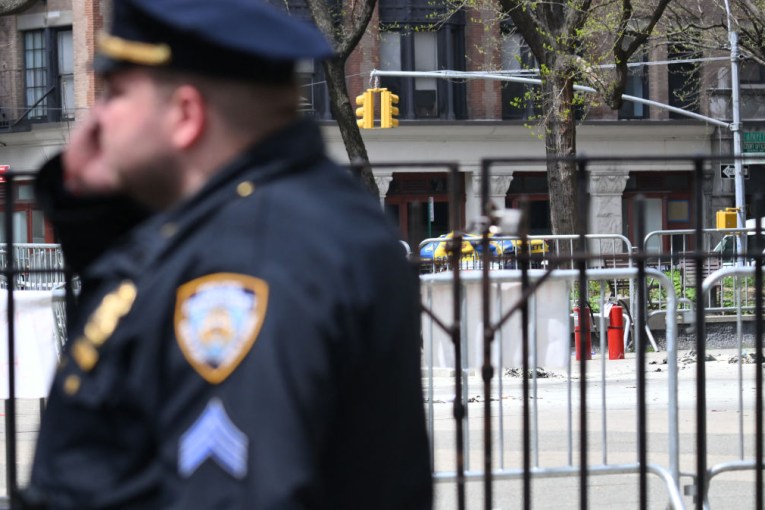Tsunami death toll passes 280 as rescuers scramble to find more survivors


Carita residents inspect what is left of a house damaged by a tsunami. Photo: AP
Rescuers in Indonesia are in a “mad scramble against the clock” to find survivors after Saturday’s devastating tsunami, World Vision Australia chief advocate Tim Costello says.
“It’s a race against time to save anyone who is still alive,” he told Sky news.
“The death toll always rises.”
Mr Costello said the lack of warning before the tsunami hit the islands of Java and Sumatra hit would need to be addressed.
Semua rata tanah diterjang tsunami di daerah Pantai Batu Hideung Desa Tanjung Jaya Kec Tanjung Lesung, Pandeglang. Evakuasi masih terus dilakukan tim SAR gabungan. Korban terus ditemukan hingga 24/12/2018. pic.twitter.com/ygG2hlDVNk
— Sutopo Purwo Nugroho (@Sutopo_PN) December 24, 2018
Residents and holidaymakers on Indonesia’s Sunda Strait apparently had little or no warning before the wave swept the coastline, killing hundreds.
Beaches in the Pandenglang district, South Lampung and Serang in the Sunda Strait, between the islands of Java and Sumatra, were the worst affected. Indonesian news websites reported people running in fear from five-metre waves after the tsunami hit at 9.27pm on Saturday.
The death toll from the tsunami – triggered by volcanic eruptions on Mount Krakatoa – has risen to more than 280. At least 1000 others have been injured.
Authorities expect the toll to rise as rescuers continue to search for victims in remote areas of the province.
The Australian Embassy in Jakarta is liaising with local authorities to determine if any Australians are affected. The Department of Foreign Affairs and Trade said on Monday that its current advice was that no foreigners were involved in the disaster.
Wow. This is the volcano “Child of Krakatoa” believed to have caused the Indonesian Tsunami. Video courtesy of Susi Air #tsunami pic.twitter.com/v99DT1KJ4N
— David Lipson (@davidlipson) December 23, 2018
Tsunami expert Associate Professor David Kennedy, from the University of Melbourne, said Australians might have been in the vicinity of the disaster.
“It’s probably unlikely, but I’d say it’s not impossible. Australians tend to get around everywhere,” he said.
He said it was unusual that there was no warning before the wave struck.
“The first thing they [the victims] noticed was the tsunami was there. The most common cause is an earthquake, so you’ll feel the rumbling. But because this was a very active volcano … there wasn’t any shaking.”
No earthquake meant the ground did not shake to warn people of the incoming wave . It ripped buildings from their foundations in seconds and swept terrified concertgoers from a popular resort beach into the sea.
Disaster Mitigation Agency spokesperson Sutopo Purwo Nugroho urged residents to stay away from the coast for at least 24 hours because of the potential for another tsunami.
# The #tsunami in the Sunda Strait was allegedly due to the #krakatau mountain avalanche last night pic.twitter.com/nwYlNw5YLk
— alam raya (@Syarief38194795) December 22, 2018
Meteorological agency head Rahmat Triyono urged Sunda Strait residents to remain vigilant.
“Please do not be around the beaches around the Sunda Strait. Those who have evacuated, please do not return yet,” Mr Triyono said.
In the city of Bandar Lampung on Sumatra, hundreds of residents took refuge at the governor’s office. At the popular resort area of Anyer beach on Java, some survivors wandered in the debris.
Many of the dead were thought to be tourists, many from Jakarta.
Dozens of buildings were damaged, Indonesia’s Disaster Mitigation Agency said. It expects the death toll to grow once authorities hear from all stricken areas.

The tangled remains of what was a home blanket a drowned car in the town of Caritas after the wall of water rolled through. Photo: AAP
The Disaster Mitigation Agency said the tsunami was possibly caused by landslides from the Mount Anak Krakatau volcano and tidal waves due to the full moon.
“The two combinations caused a sudden tsunami that hit the coast,” the agency said.
Dramatic video posted on social media showed the Indonesian pop band Seventeen performing under a tent on popular Tanjung Lesung beach at a concert for employees of a state-owned electricity company.
Norwegian volcano photographer Oystein Andersen was on the beach taking photos of the volcano after the earlier eruptions when the waves came.
This (awful) video shows the Indonesian band Seventeen in concert at the Tanjung Lesung beach in Banten – until the tsunami struck. It has been widely shared online. The band’s bass player and road manager are dead, three other band members and the singer’s wife are missing pic.twitter.com/Yejoq8D4zG
— James Massola (@jamesmassola) December 23, 2018
“I had to run, as the wave passed the beach and landed 15-20m inland,” Andersen wrote on Facebook.
“Next wave entered the hotel area where i was staying and downed cars on the road behind it. Managed to evacuate with my family to higher ground trough forest paths and villages, where we are taken care of (by) the locals. Were unharmed, thankfully.”
Videos posted on social media showed flooded streets, an overturned car and people running up stairs to escape the waves.
Nine hotels and hundreds of homes were heavily damaged by the waves.

Krakatoa sits in the middle of the Sunda Strait, giving those living on adjacent shores little chance or warning of its deadly eruptions.
Broken chunks of concrete and splintered sticks of wood littered hard-hit coastal areas, turning beach getaways popular with Jakarta residents into near ghost towns.
Vehicles were tossed into the rubble or were buried under collapsed roofs. Debris from thatch-bamboo shacks was strewn along beaches.
Yellow, orange and black body bags were laid out, and weeping relatives identified the dead.

A survivor receives medical treatment at a hospital in Carita. Photo: AFP/Gett
The tsunami triggered memories for some of the 9.1-magnitude earthquake that struck a dozen countries on December 26, 2004.
It spawned a giant tsunami off Sumatra island in western Indonesia, killing more than 230,000 people.
The Volcanology and Geological Hazard Mitigation Centre notes that there are 20 volcanoes with above-normal levels of activity across Indonesia.
-with AAP








